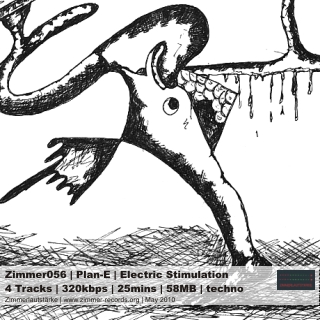Zimmer056 – plan-e – electric stimulation (Germany)
mp3, 320kbps, stereo, techno, tool, breaks
056.01 – plan-e – stromschlag
056.02 – plan-e – socket
056.03 – plan-e – later
056.04 – plan-e – slow motion
download & stream -> archive.org
download & stream -> sonicsquirrel.net
download & stream -> last.fm
download ZIP (MP3 | 58MB)
Artwork (666px)
[by nadrealizam]
Electrical stimulation for the purpose of helping persons with paralysis of the arms or legs mainly focuses on the neuromuscular transmission peripherally. E-stim can also be used for central nervous system stimulation to hasten awakening from coma or the vegetative state. There is a long history of neurosurgeons who have implanted electrodes into the brain and spinal cord, especially in Japan, for increasing cerebral blood flow and certain neurotransmitters in persons in long term coma states.
Neurons are electrically active cells. Presence of the electric field in nervous tissue leads to the depolarization of neuronal lipid membranes and induces firing of action potential. FES takes advantage of this property of nerve cells. Passing electric current through nervous tissue can lead to adverse effects such as decrease in excitability or cell death due to thermal damage, electroporation, toxic products from electrochemical reactions or overexcitation of neurons. Special care should be taken in designing safe FES. Typical stimulation protocol that are used in clinical FES involves either AC or DC stimulation. For AC stimulation, a train of electric pulses is delivered. Biphasic, charged balanced pulses are employed as it ensures safety of electrical stimulation and minimizes adverse effects. Pulse width, charge per phase and frequency are the key parameters that define safety and effectiveness of FES. Furthermore, polarity of a biphasic pulse, which can be either cathodic first or anodic first, have different threshold for activation of nervous tissue. For peripheral nerves stimulation, cathodic first pulses have lower threshold and more efficient for charge delivery. For surface cortical simulation, where axons are perpendicular to the electrode surface, anodic first pulses are more efficient. //wikipedia
